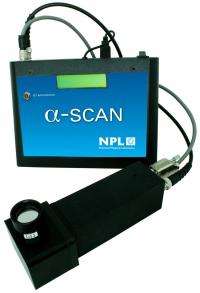NPL builds long range alpha detector

The UK's National Physical Laboratory (NPL) has developed a new portable radiation detector that can assess the safety of potentially contaminated areas far quicker than current methods. The prototype was inspired by the aftermath of the murder of Alexander Litvinenko in London 2006.
Litvinenko's death was due to radiation poisoning from polonium-210. It prompted wide-scale work to assess radiation levels at almost 50 premises in London that he had been prior to his death before opening them up again to the public, costing the Health Protection Agency £2 million.
The clean up process took an extended period of time as scintillation counters were used to detect alpha particles and therefore measure the radiation levels. Alpha particles only have a range of about 2 cm and can be suppressed by surface moisture and roughness. Geiger counters also require a skilled operator to work, making it a painstaking and laborious process to scan wide areas very close to the surface.
NPL has developed a prototype device which can detect the optical photons generated by alpha particles in air, thus having a far greater range.
Alpha particles can cause ionization of nitrogen in air, which in turn produces fluorescence photons that show up as discrete spectral lines in the UV band of the electromagnetic spectrum. These photons can travel much further than alpha particles and are not hindered by surface particles or roughness and can be transmitted through any UV transparent material such as plastic or glass. This means an area could be made safe before a contamination assessment is carried out.
NPL has developed a portable device for low-level monitoring in normal lighting conditions. Laboratory tests have shown that the prototype is capable of detecting alpha induced nitrogen fluorescence at distances greater than the range of alpha particles (2 cm). The prototype has demonstrated detection up to 20 cm, limited currently by the optics on the device. However, the principle is completely scaleable with small devices having a range of cms and non-portable devices reaching kms.
Ray Chegwin, Business Development Manager at NPL, said: "NPL has a strong heritage of using world class measurement science to benefit society and industry in the UK and beyond. By producing a prototype that can measure radiation up to ten times further away than current methods we can greatly improve the time it takes to safely assess any suspected radioactive areas. Our prototype could have saved the time it took to monitor the areas relevant to the Litvinenko case, and cut the costs of such an essential operation. Of course, the detector could be used to support radiation safety and decommissioning operations in the nuclear industry, amongst others, and we're currently investigating these."
Provided by National Physical Laboratory

















